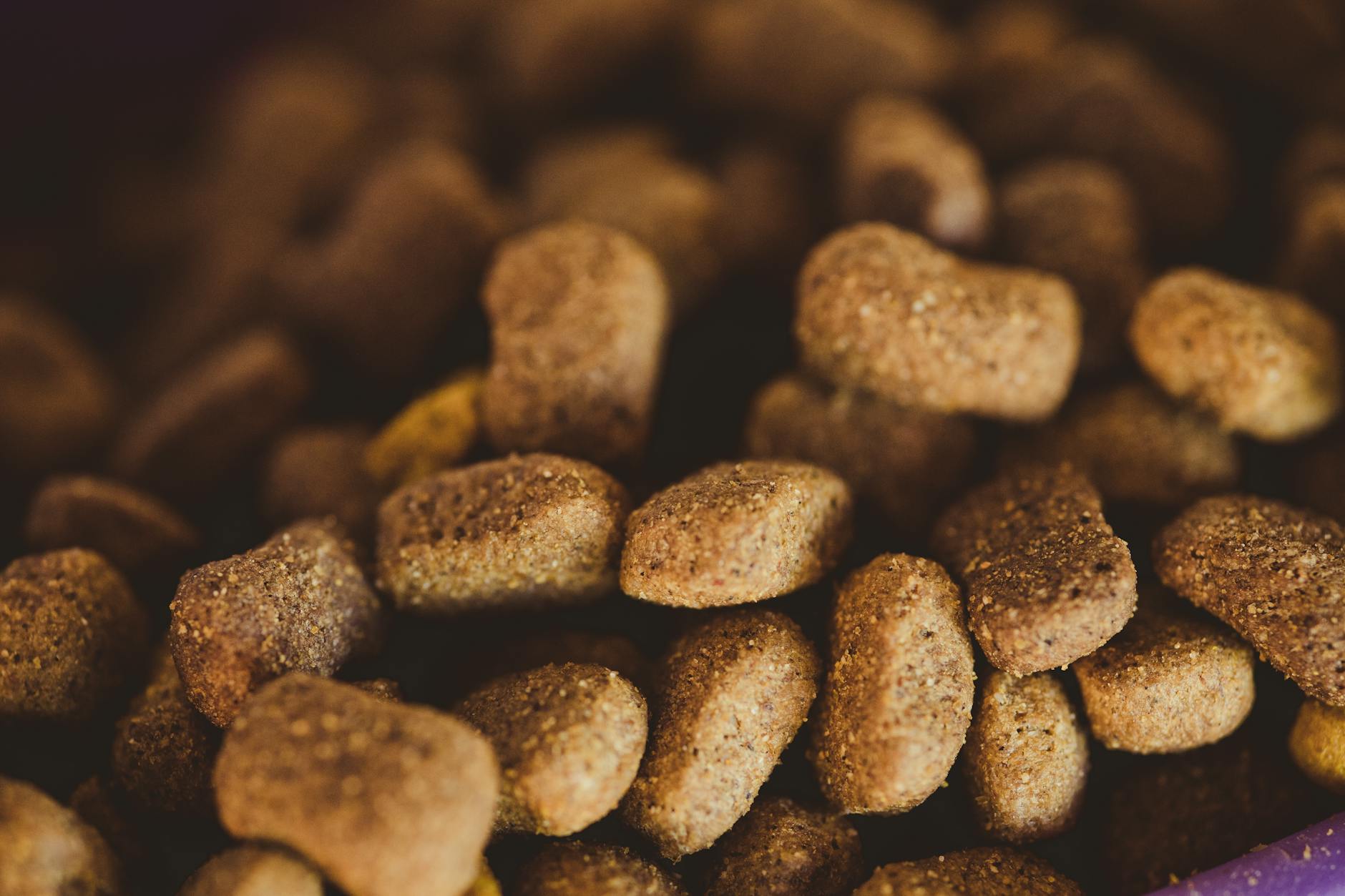Dog Protein Requirements: A Simple Guide for Every Life Stage

Dog Protein Requirements. Protein plays a massive role in keeping dogs healthy and active. It fuels their growth, muscles, and overall well-being. But how much protein does your dog need? That depends on their size, age, and lifestyle. For example, active breeds or puppies may crave more protein than a senior dog lounging at home.
Choosing the right food isn’t just about filling their bowl—it can make a big difference in their energy and longevity. If you’re curious about adjustments for specific breeds, check out dog foods for American Pit Bull Terriers.
What is Protein, and Why is it Important for Dogs?
Protein is a cornerstone of your dog’s diet. It’s not just a building block for muscles; it fuels energy, supports overall health, and keeps them active and happy. If your dog isn’t getting enough protein, you could see it in their energy levels, coat condition, or mood. Let’s break down why this nutrient is so essential.
Functions of Protein in Dogs
Protein does far more than build muscles. Here are its key contributions to your dog’s health:
- Muscle Development and Repair: Protein supports the growth and repair of tissues. This is especially crucial for puppies, active dogs, and seniors experiencing muscle loss.
- Energy Production: Dogs convert protein into energy, especially if their diet lacks enough carbs or fat.
- Immune System Support: Protein helps produce antibodies to fight illnesses and infections.
- Hair, Skin, and Nails: Proteins like keratin and collagen keep your dog’s coat shiny and skin healthy.
Inadequate protein can lead to problems like lethargy, poor coat condition, and weak muscles. For a deeper dive into balancing protein levels for more energetic pups, check out Best Dog Food For Sporting Breeds.

Photo by Rafael Rodrigues
Types of Protein Sources
Not all protein is created equal. Dogs need high-quality protein sources to thrive. Let’s explore the differences:
Animal-Based Proteins
- Examples: Chicken, beef, fish, eggs
- Benefits: Animal proteins are highly digestible and provide a complete chain of amino acids, which makes them ideal for muscle building and immune support.
- Why It Matters: Most commercial dog foods incorporate animal proteins because they contribute to overall dog health.
Plant-Based Proteins
- Examples: Soy, lentils, peas, quinoa
- Benefits: While they can supplement diets, plant proteins often lack certain essential amino acids.
- Drawbacks: They’re less digestible than animal-derived proteins, so dogs may not absorb as much nutrition.
A blend of both types can balance cost and nutritional value, but protein quality and digestibility should always be your top priorities. For more insights into protein’s role in your dog’s health, check out The Importance of Protein in Dog Food.
These animal—or plant-based
protein sources provide the amino acids your dog relies on for cellular repair, energy, and a glossy coat. To find the best diet tailored to your dog’s breed, visit Best Dog Food For Every Breed: Tailored Nutrition.
Understanding the importance of protein and choosing the right sources can make a huge difference in your dog’s overall well-being. Monitor the amounts and sources in your dog’s meals to ensure they receive what they need to thrive.
Determining Your Dog’s Protein Needs
Understanding your dog’s protein requirements can feel like solving a puzzle, but it’s essential for their health and energy. Protein needs can vary significantly between dogs based on age, size, activity, and health status. In this section, we’ll break it down into manageable steps to help you determine how much protein your dog needs.
Factors Affecting Protein Requirements
When determining your dog’s protein needs, it’s essential to consider the following factors:
Age: Puppies require more protein for growth and development, while seniors may need less but higher-quality protein to maintain muscle mass. Learn more about senior dog nutrition.
Breed and Size: Larger breeds often need more protein overall, but smaller breeds may benefit from protein-dense foods to match their faster metabolism. For specific breed insights, check out best food options for Boxers.
Activity Level: Active and working dogs burn more energy and require higher protein levels to maintain muscle and stamina.
Health Conditions: Some medical issues, like kidney disease, might require adjusted protein levels. Always consult your vet for personalized advice.
These considerations make protein needs highly individual. No one-size-fits-all answer works here, so understanding your dog’s unique requirements is key.

Photo by Mathew Coulton
Calculating Protein Needs by Weight
A helpful way to determine your dog’s protein requirements is by calculating based on their body weight. Here’s a straightforward formula to guide you:
- For adult dogs: 1 gram of protein per pound of body weight daily.
- For puppies: 2–3 grams of protein per pound of body weight per day.
For example, if your dog weighs 50 pounds, they need around 50 grams of protein daily. Highly active or pregnant dogs might need slightly more, while seniors may require adjustments based on health conditions.
If you’re curious to dive deeper, this minimum protein calculator for dog food might help you fine-tune your dietary requirements. Consider consulting a vet to ensure these estimates align with your pet’s health needs.
Breaking down these requirements can turn a seemingly complex task into something simple and actionable, ensuring your dog gets the nourishment they deserve.
Protein Requirements for Different Life Stages
Protein needs for dogs aren’t static; they change across life stages. Whether they’re just starting out as playful puppies or cooling down in their senior years, their protein demands shift with time. Let’s explore how you can optimize their diet at each phase.
Puppies and Growing Dogs
Puppies are a whirlwind of activity and growth. Their bodies are busy building bones, muscles, and organs, which require higher protein intake. Puppies usually need 22–32% protein to support this rapid development, depending on their breed and size. Protein for puppies isn’t just about quantity—quality is just as crucial. Look for complete proteins such as those from chicken, fish, or beef.
For example, Akita puppies require balanced protein and fat to grow appropriately during their early months. If you’re curious, check out Top 5 Dog Foods to Support Akita Puppies.
Puppy food labels often categorize the proper protein levels for growth, so always check the packaging. If you’re in doubt, most high-quality puppy foods will meet these needs, but it’s a good idea to consult your vet for added assurance.

Photo by MART PRODUCTION
Adult Dogs
Once dogs reach adulthood, their protein needs stabilize. The diet should include about 18–25% protein for most healthy adult dogs, depending on activity level. For example:
- High-energy breeds like Border Collies may benefit from protein-rich diets to sustain muscle tissue.
- Less active dogs require less protein, making balance key.
Protein isn’t the only nutrient at play; fats, vitamins, and carbohydrates contribute to a well-rounded diet. A misstep in this phase can lead to weight gain or other health issues. Explore Best Dog Food for Border Collies to tailor options for specific breeds.
If you’re unsure about calculating protein intake, a helpful guideline is 1 gram of protein per pound of body weight daily. However, this may vary for breeds with unique needs or health conditions.
For more context, here’s a helpful external resource: Feeding Guidelines for Different Life Stages of Pets.
Senior Dogs
As dogs age, their metabolism slows, and staying active may become more challenging. While some people think senior dogs need less protein, the opposite is often true. Aging dogs require higher-quality yet easily digestible proteins to maintain muscle mass and prevent muscle loss due to inactivity.
The key here is protecting kidney health while ensuring they get adequate protein. Higher-quality proteins from sources like eggs, lean meats, or fish help prevent strain while delivering essential amino acids. This phase emphasizes quality over sheer quantity; roughly 20% protein in their diet is ideal for most senior dogs. For more insights, check out How to Spot Nutritional Deficiencies in Your Dog.
Monitoring a senior dog’s health and consulting with your vet can make all the difference. You can dig into specialized recommendations through the detailed guide: Optimizing Your Dog’s Diet for Every Life Stage.
Protein is the backbone of your dog’s nutritional needs, but knowing how to adjust these requirements as they grow ensures a healthy, happy life. From bounding puppies to wise old seniors—every stage calls for thoughtful planning regarding protein.
Choosing the Right Dog Food
Getting the best food for your dog is more than a trip down the pet aisle—it’s a step toward ensuring their health and happiness. Let’s simplify this process and focus on key factors like understanding labels and which brands cater to your dog’s unique needs.
Reading Dog Food Labels
Understanding dog food labels can initially feel overwhelming, but it’s the gateway to making informed decisions about your dog’s diet. Protein content is a great place to start when looking at labels. Most labels share clear protein, fat, and fiber percentages through the guaranteed analysis feature.
Here are quick tips to guide you:
- Look for Protein Sources First: Ingredients are listed in descending order by weight. A named meat (like chicken or beef) should top the list.
- Avoid Fillers: Watch out for vague terms like “meat by-products” or “meal.” Instead, choose foods with whole, recognizable ingredients.
- Check Analysis Standards: The Association of American Feed Control Officials (AAFCO) sets nutritional guidelines, so pick a product that meets or exceeds these standards.
- Allergy Considerations: Scan the label for potential triggers if your dog has sensitivities.
For more details about what ingredients to watch, check out What Ingredients to Avoid in Dog Food. Keeping an eye on these details ensures you’re feeding your pup the quality proteins they deserve.

Photo by MART PRODUCTION
Recommended Dog Food Brands
Finding the right brand can feel like finding a needle in a haystack. Every dog has unique needs, so the best dog food might differ for a Chihuahua versus a German Shepherd. Here’s a quick breakdown of some popular options:
- Active Dogs or Sporting Breeds: Foods like Purina Pro Plan Sport deliver higher protein levels for active dogs that burn off energy. Explore dog food brand comparisons to weigh your options.
- Dogs with Sensitive Stomachs: Brands like Hill’s Science Diet often cater to dogs with unique dietary restrictions. Visit Best Dog Food for Sensitive Stomachs for tailored options.
- Natural Diet Seekers: Human-grade, fresh options like Farmer’s Dog have become a staple for those seeking natural alternatives. Learn more through this guide on The Farmer’s Dog Food.
If you’re still unsure or want expert-backed insights, the American Kennel Club’s guide offers actionable advice for choosing the right dog food tailored to your furry companion’s specific requirements.
By combining careful label reading and exploring the top dog food brands, you’ll find something that suits both your dog’s needs and your peace of mind. When in doubt, consult your vet for personalized advice to make the best choice.
Common Myths About Dog Protein Needs
Understanding the facts about protein for dogs can feel overwhelming, especially with so many myths floating around. It’s time to separate truth from fiction so you can make the best choices for your furry friend. Below, we’ll address two of the most common myths about dog protein needs and provide clarity backed by expert guidance.
High Protein Diets Are Dangerous
One of the most persistent myths is that high-protein diets harm dogs, especially their kidneys. This idea likely stems from confusion around certain health conditions. For most healthy dogs, research shows no evidence that a high-protein diet damages kidneys or other organs.
Dogs are natural carnivores, and their bodies process protein efficiently. Protein provides essential amino acids for muscle growth, energy, and a shiny coat. Unless a dog has specific issues like kidney disease (in which case a vet may recommend adjustments), higher protein levels typically support their overall well-being.
Moreover, many active and working breeds thrive on protein-rich meals due to their higher energy needs. If you’re curious about specific dietary options, check out Best Dog Food for Herding Breeds.
You can read resources like The Truth Behind 8 Dog Food Myths for additional insights into dispelling this myth.
All Dogs Require the Same Protein Amount
Another big myth that needs debunking is the idea that all dogs need the same amount of protein. The truth? Protein needs vary widely depending on age, breed, activity level, and health conditions.
- Puppies require more protein to support growth. Foods designed for young dogs often contain around 22-32% protein.
- Active breeds like Blue Heelers often need higher protein levels to sustain energy and muscle strength. Learn more at Best Dog Food for Blue Heelers.
- Senior dogs benefit from high-quality protein for muscle maintenance, though their overall intake may be less than that of a young, active dog.
Each dog is unique. That’s why understanding their specific lifestyle and health is crucial. A one-size-fits-all approach to protein doesn’t work. Check out Debunking 5 Common Dog Nutrition Myths for more details on balancing protein intake.
By tailoring protein intake to your dog’s needs, you can ensure they get the nutrients they need for a happy, healthy life.
Frequently Asked Questions About Dog Protein Requirements
Dog protein needs can spark many questions, mainly since they depend on factors like age, activity, and health. Below, we’ve answered some of the most common queries to help you better understand your dog’s nutrition.
How Much Protein Does My Dog Need?
Protein needs vary by dog. Puppies and highly active breeds generally require more protein than seniors or laid-back pets. A simple guideline to remember:
- Puppies: 22–32% of their daily intake should be protein.
- Active Adult Dogs: Around 20–25%.
- Senior Dogs: Close to 18–20%, focusing on high-quality sources.
For detailed insights, check out this helpful guide on how much protein a dog needs.
What Happens If My Dog Doesn’t Get Enough Protein?
Not getting enough protein can lead to:
- Loss of muscle mass.
- A dull coat or flaky skin.
- Lethargy and reduced stamina.
- Weaker immune function.
These signs might look like general aging, but lack of protein could be the hidden culprit. Always prioritize high-quality protein in your dog’s diet. For breed-specific food recommendations, explore Best Dog Foods for Corgis.
Can Dogs Have Too Much Protein?
It’s a misconception that high-protein diets are harmful to healthy dogs. Their bodies efficiently process protein, and excess is usually converted into energy or stored. However, dogs with kidney issues need tailored diets. Always consult your vet for personalized advice.
For more information, visit this trusted guide to dog protein needs.
Should I Choose Animal-Based or Plant-Based Protein?
Dogs benefit more from animal-based protein due to its complete amino acid profile. Familiar sources include chicken, beef, and fish. While plant-based proteins (like peas or lentils) can supplement the diet, they often lack essential amino acids.
A mix of both can balance cost and nutrition, but prioritize digestibility for your pup. Learn more about sources in our breakdown Best Dry Dog Food.

Photo by Anna Shvets
How Do I Measure Protein in Dog Food?
Check the label for “crude protein” in the guaranteed analysis section. Aim for foods with precise, named ingredients like chicken or beef as the primary source. If the first ingredient is vague, such as “meat meal,” it may indicate lower-quality protein.
Need help figuring out dog food labels? Read our specific guide on How to Avoid Unhealthy Ingredients in Dog Food.
Can Protein Needs Change Over Time?
Protein needs shift depending on a dog’s life stage, activity level, and health. Puppies and lactating dogs need more, while senior dogs might focus on quality, not just quantity. Adjust your pup’s diet based on their activity level as they age.
For aging dogs, find tailored protein advice at How to Choose the Best Wet Food for Aging Akitas.
Feel free to bookmark these answers; they’ll serve as a helpful reference for ensuring your dog’s health through proper protein intake.
Conclusion
Feeding the right amount of protein isn’t just science—it’s care. Your dog’s energy and wellness thrive when their protein intake matches their age, breed, and lifestyle. Puppies, adult dogs, and seniors each have unique needs that require careful attention.
Assess your dog’s food labels and watch for quality protein sources like chicken, beef, or fish. If you’re still deciding which food is best, explore tailored insights like Best Dog Food for American Bullies.
Make every meal count. Your dog’s nutrition is the foundation of their health and happiness. For practical tips, visit Nutrition Tips to keep them on track.








One Comment